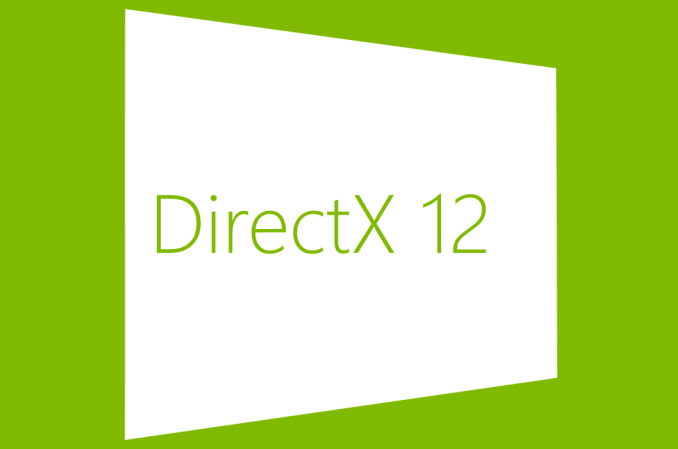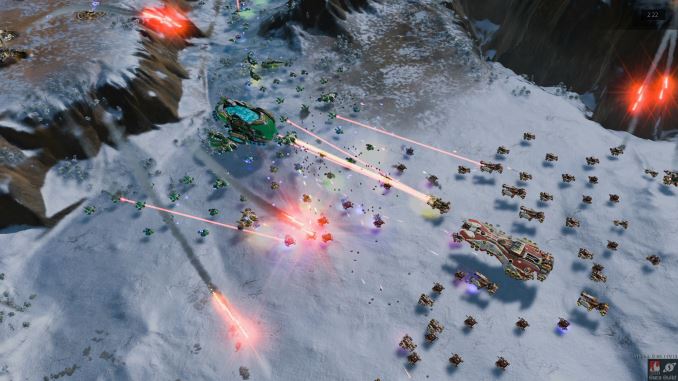Ashes of the Singularity Revisited: A Beta Look at DirectX 12 & Asynchronous Shading
by Daniel Williams & Ryan Smith on February 24, 2016 1:00 PM EST
We’ve been following DirectX 12 for about 2 years now, watching Microsoft’s next-generation low-level graphics API go from an internal development project to a public release. Though harder to use than earlier high-level APIs like DirectX 11, DirectX 12 gives developers more control than ever before, and for those who can tame it, they can unlock performance and develop rendering techniques simply not possible with earlier APIs. Coupled with the CPU bottlenecks of DirectX 11 coming into full view as single-threaded performance increases have slowed and CPUs have increased their core counts instead, and DirectX 12 could not have come at a better time.
Although DirectX 12 was finalized and launched alongside Windows 10 last summer, we’ve continued to keep an eye on the API as the first games are developed against it. As developers need the tools before they can release games, there’s an expected lag period between the launch of Windows 10 and when games using the API are ready for release, and we are finally nearing the end of that lag period. Consequently we’re now getting a better and clearer picture of what to expect with games utilizing DirectX 12 as those games approach their launch.
There are a few games vying for the title of the first major DirectX 12 game, but at this point I think it’s safe to say that the first high profile game to be released will be Ashes of the Singularity. This is due to the fact that the developer, Oxide, has specifically crafted an engine and a game meant to exploit the abilities of the API – large numbers of draw calls, asynchronous compute/shading, and explicit multi-GPU – putting it a step beyond adding DX12 rendering paths to games that were originally designed for DX11. As a result, both the GPU vendors and Microsoft itself have used Ashes and earlier builds of its Nitrous engine to demonstrate the capabilities of the API, and this is something we’ve looked at with both Ashes and the Star Swarm technical demo.
Much like a number of other games these days, Ashes of the Singularity for its part has been in a public beta via Steam early access, while its full, golden release on March 22nd is fast approaching. To that end Oxide and publisher Stardock are gearing up to release the second major beta of the game, and the last beta before the game goes gold. At the same time they’ve invited the press to take a look at the beta and its updated benchmark ahead of tomorrow’s early access release, so today we’ll be taking a second and more comprehensive look at the game.
The first time we poked at Ashes was to investigate an early alpha of the game’s explicit multi-GPU functionality. Though only in a limited form at the time, Oxide demonstrated that they had a basic implementation of DX12 multi-GPU up and running, allowing us to not only pair up similar video cards, but dissimilar cards from opposing vendors, making a combined GeForce + Radeon setup a reality. This early version of Ashes showed a lot of promise for DX12 multi-GPU, and after some additional development it is now finally being released to the public as part of this week’s beta.
Since that release Oxide has also been at work both cleaning up the code to prepare it for release, and implementing even more DX12 functionality. The latest beta adds greatly improved support another one of DX12’s powerhouse features: asynchronous shading/computing. By taking advantage of DX12’s lower-level access, games and applications can directly interface with the various execution queues on a GPU, scheduling work on each queue and having it executed independently. Async shading is another one of DX12’s optimization features, allowing for certain tasks to be completed in less time (lower throughput latency) and/or to better utilize all of a GPU’s massive arrays of shader ALUs.
Between its new functionality, updated graphical effects, and a significant amount of optimization work since the last beta, the latest beta for Ashes gives us quite a bit to take a look at today, so let’s get started.












153 Comments
View All Comments
Kouin325 - Friday, February 26, 2016 - link
yes indeed they will be patching DX12 into the game, AFTER all the PR damage from the low benchmark scores is done. Nvidia waved some cash at the publisher/dev to make it a gameworks title, make it DX11, and to lock AMD out of making a day 1 patch.This was done to keep the general gaming public from learning that the Nvidia performance crown will all but disappear or worse under DX12. So they can keep selling their cards like hotcakes for another month or two.
Also, Xbox hasn't been moved over to DX12 proper YET, but the DX11.x that the Xbox one has always used is by far closer to DX12 than DX11 for the PC. I think we'll know for sure what the game was developed for after the patch comes out. If the game gets a big performance increase after the DX12 patch then it was developed for DX12, and NV possibly had a hand in the DX11 for PC release. If the increase is small then it was developed for DX11,
Reason being that getting the true performance of DX12 takes a major refactor of how assets are handled and pretty major changes to the rendering pipeline. Things that CANNOT be done in a month or two or how long this patch is taking to come out after release.
Saying "we support DirectX12" is fairly ease and only takes changing a few lines of code, but you won't get the performance increases that DX12 can bring.
Kouin325 - Friday, February 26, 2016 - link
ugh, I think Firefox had a brainfart, sorry for the TRIPPLE post.... *facepalm*Gothmoth - Friday, February 26, 2016 - link
it´s a crap game anyway so who cares?honestly even when nvidia should be 20% worse i would not buy ATI.
not becasue im a fanboy.. but i use my GPU´s for more than games and ATI GPUs suck big time when it comes to drivers stability in pro applications.
D. Lister - Friday, February 26, 2016 - link
Oxide and their so called "benchmarks" are a joke. Anyone who takes the aforementioned seriously, is just another unwitting victim of AMD's typical underhanded marketing.https://scalibq.wordpress.com/2015/09/02/directx-1...
"And don’t get me started on Oxide… First they had their Star Swarm benchmark, which was made only to promote Mantle (AMD sponsors them via the Gaming Evolved program). By showing that bad DX11 code is bad. Really, they show DX11 code which runs single-digit framerates on most systems, while not exactly producing world-class graphics. Why isn’t the first response of most people as sane as: “But wait, we’ve seen tons of games doing similar stuff in DX11 or even older APIs, running much faster than this. You must be doing it wrong!”?
But here Oxide is again, in the news… This time they have another ‘benchmark’ (do these guys actually ever make any actual games?), namely “Ashes of the Singularity”.
And, surprise surprise, again it performs like a dog on nVidia hardware. Again, in a way that doesn’t make sense at all… The figures show it is actually *slower* in DX12 than in DX11. But somehow this is spun into a DX12 hardware deficiency on nVidia’s side. Now, if the game can get a certain level of performance in DX11, clearly that is the baseline of performance that you should also get in DX12, because that is simply what the hardware is capable of, using only DX11-level features. Using the newer API, and optionally using new features should only make things faster, never slower. That’s just common sense."
Th-z - Saturday, February 27, 2016 - link
“But wait, we’ve seen tons of games doing similar stuff in DX11 or even older APIs..."Doing similar stuff in DX11? What stuff and what games?
"The figures show it is actually *slower* in DX12 than in DX11. But somehow this is spun into a DX12 hardware deficiency on nVidia’s side."
Which figure?
This is Anandtech, we need to be more specific and provide solid evidence to back up your claims in order to avoid sounding like an astroturfer.
D. Lister - Saturday, February 27, 2016 - link
You see my post? You see that there is this underlined text in blue? Well my friend, it is called a URL, which is an acronym for "Uniform Resource Locator", long story short it is this internet thingy that you go clickity-clickity with your mouse and it opens another page, where you can find the rest of the information.Don't worry, the process of opening a new webpage by using a URL may APPEAR quite daunting at first, but with very little practice you could be clicking away like a pro. This is after all "The AnandTech", and everybody is here to help. Heck, who knows if there are more like you out there, I might even make a video tutorial - "Open new webpages in 3 easy steps", or something.
PS: Another pro tip, there is no such thing as "solid evidence" outside of a court of law. On the internet, you have information resources and reference material, and you have to use your own first-hand knowledge, experience and commonsense to differentiate the right from wrong.
Th-z - Sunday, May 29, 2016 - link
Your blabbering is as useful as your link. I have a pro tip for you: you gave yourself away.EugenM - Tuesday, June 7, 2016 - link
@Th-z Dont feed the troll.GeneralTom - Saturday, February 27, 2016 - link
I hope Metal will be supported, too.HollyDOL - Monday, February 29, 2016 - link
Hm, from the screenshots posted I honestly can't see why would there be a need to run Dx12 with so "low performance" even on the most elite cards. While I give these guys credits for having the guts to go and develop in completely new API, the graphics looks more like early Dx9 games.Just a note this opinion is based on screenshots, not actual live render, but still from what I see there I'd expect FPS hitting 120+ with Dx11...